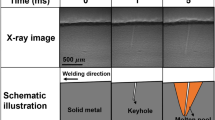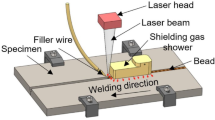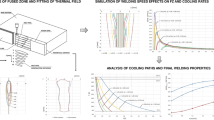Abstract
In this paper, an experimental study combined with a numerical model consideration of both thermal conduction and fluid flow in the molten pool were carried out, aiming to analyze solidification cracking susceptibility of dual-beam laser welding on Al alloys. The maximum accumulated transverse displacement in the mushy zone was calculated based on the strip expansion technique and employed to evaluate centerline solidification cracking susceptibility. Numerical calculations showed that increasing inter-beam spacing in side-by-side dual-beam laser welding of Al alloys could lead to increased accumulated transverse displacement in the weld, resulting in higher solidification cracking susceptibility, which agreed well with experimental observations. The analysis results also showed that increasing the laser power or reducing the welding velocity increased hot cracking susceptibility. The optimum cracking-free welding condition for dual-beam laser welding of Al can be determined with the help of numerical modeling, in which the hot cracking susceptibility can be evaluated and numerically reduced by adjusting welding process variables.
Similar content being viewed by others
References
Rappaz M, Drezet JM, Gremaud M (1999) A new hot-tearing criterion. Metall Mater Trans A 30:449–455
Kou S (2003) Solidification and liquation cracking issues in welding. Jom 55:37–42
Eskin DG, Suyitno KL (2004) Mechanical properties in the semi-solid state and hot tearing of aluminum alloys. Prog Mater Sci 49:629–711
Chen HC, Pinkerton AJ, Li L (2011) Fiber laser welding of dissimilar alloys of Ti-6Al-4V and Inconel 718 for aerospace applications. Int J Adv Manuf Technol 52:977–987
Gao ZG (2012) Numerical modeling to understand liquation cracking propensity during laser and laser hybrid welding (I). Int J Adv Manuf Technol 63:291–303
Akesson B, Karlsson L (1976) Prevention of hot cracking of butt welds in steel panels by controlled additional heating of the panels. Weld Res Int 6:35–52
Glumann C, Rapp J, Dausinger F, Hugel H (1993) Welding with combination of two CO2 lasers-advantages in processing and quality. Proceedings of ICALEO’ 93 international conference on applications of lasers and electro-optics, Orlando, pp 672–681
Scott A, Frewin M (1997) Tandem Nd:YAG laser welding. Proceedings of ICALEO’ 97 international conference on applications of lasers and electro-optics, San Diego
Plochikhine V, Zoch HW, Karkhin VA, Makhutin M, Pesch HJ (2002) Numerical optimization of the temperature field for the prevention of solidification cracking during laser beam welding using the multi-beam technique. In : Proceedings of international conference on materials week, pp:1-7
Xie J (2002) Dual-beam laser welding. Weld J 81:223–230
Drezet JM, Lima MSF, Wagniere JD, Rappaz M, Kurz W (2008) Crack-free aluminum alloy welds using a twin laser process. In : Proceedings of international conference on safety and reliability of welded components in energy and processing industry, pp:87-94
Chen W, Molian P (2008) Dual-beam laser welding of ultra-thin AA 5052-H19 aluminum. Int J Adv Manuf Technol 39:889–897
Hsu R, Engler A, Heinemann S (1998) The gap bridging capability in laser tailored blank welding. In: Proceedings of ICALEO’ 98 international conference on applications of lasers and electro-optics, pp:225-231
Ploshikhin V, Prihodovsky A, Ilin A (2011) Experimental investigation of the hot cracking mechanism in welds on the microscopic scale. Front Mater Sci 5:135–145
Furukawa K, Katoh M, Nishio K, Yamaguchi T, Nagata F (2007) Evaluation of welds of aluminum alloy AA6022-T4 welded using an electrode force changeable resistance spot welding machine. Weld Int 21:471–481
Voller VR, Prakash C (1987) A fixed grid numerical modeling methodology for convection-diffusion mushy region phase-change problems. Int J Heat Mass Transfer 30:1709–1719
Mundra K, DebRoy T, Kelkar KM (1996) Numerical prediction of fluid flow and heat transfer in welding with a moving heat source. Numer Heat Transfer A 29:115–129
Moraitis GA, Labeas GN (2008) Residual stress and distortion calculation of laser beam welding for aluminum lap joints. J Mater Process Technol 198:260–269
Guo H, Hu J, Tsai HL (2010) Three-dimensional modeling of gas metal arc welding of aluminum alloys. J Manuf Sci Eng 132:021011
Chihoski RA (1972) The character of stress fields around a weld arc moving on aluminum sheet. Weld J 51:9–18
Kong F, Kovacevic R (2010) 3D finite element modeling of the thermally induced residual stress in the hybrid laser/arc welding of lap joint. J Mater Process Technol 210:941–950
Cao X, Wallace W, Immarigeon JP, Poon C (2003) Research and progress in laser welding of wrought aluminum alloys. II. Metallurgical microstructures, defects, and mechanical properties. Mater Manuf Process 18:23–49
Hu B, Richardson IM (2006) Mechanism and possible solution for transverse solidification cracking in laser welding of high strength aluminum alloys. Mater Sci Eng A 429:287–294
Guillaume T, Corinne A, Eric L, Jean-Michel Q (2013) Control of aluminum laser welding conditions with the help of numerical modeling. J Mater Process Technol 213:337–348
Author information
Authors and Affiliations
Corresponding author
Rights and permissions
About this article
Cite this article
Wang, X., Wang, HP., Lu, F. et al. Analysis of solidification cracking susceptibility in side-by-side dual-beam laser welding of aluminum alloys. Int J Adv Manuf Technol 73, 73–85 (2014). https://doi.org/10.1007/s00170-014-5810-y
Received:
Accepted:
Published:
Issue Date:
DOI: https://doi.org/10.1007/s00170-014-5810-y




